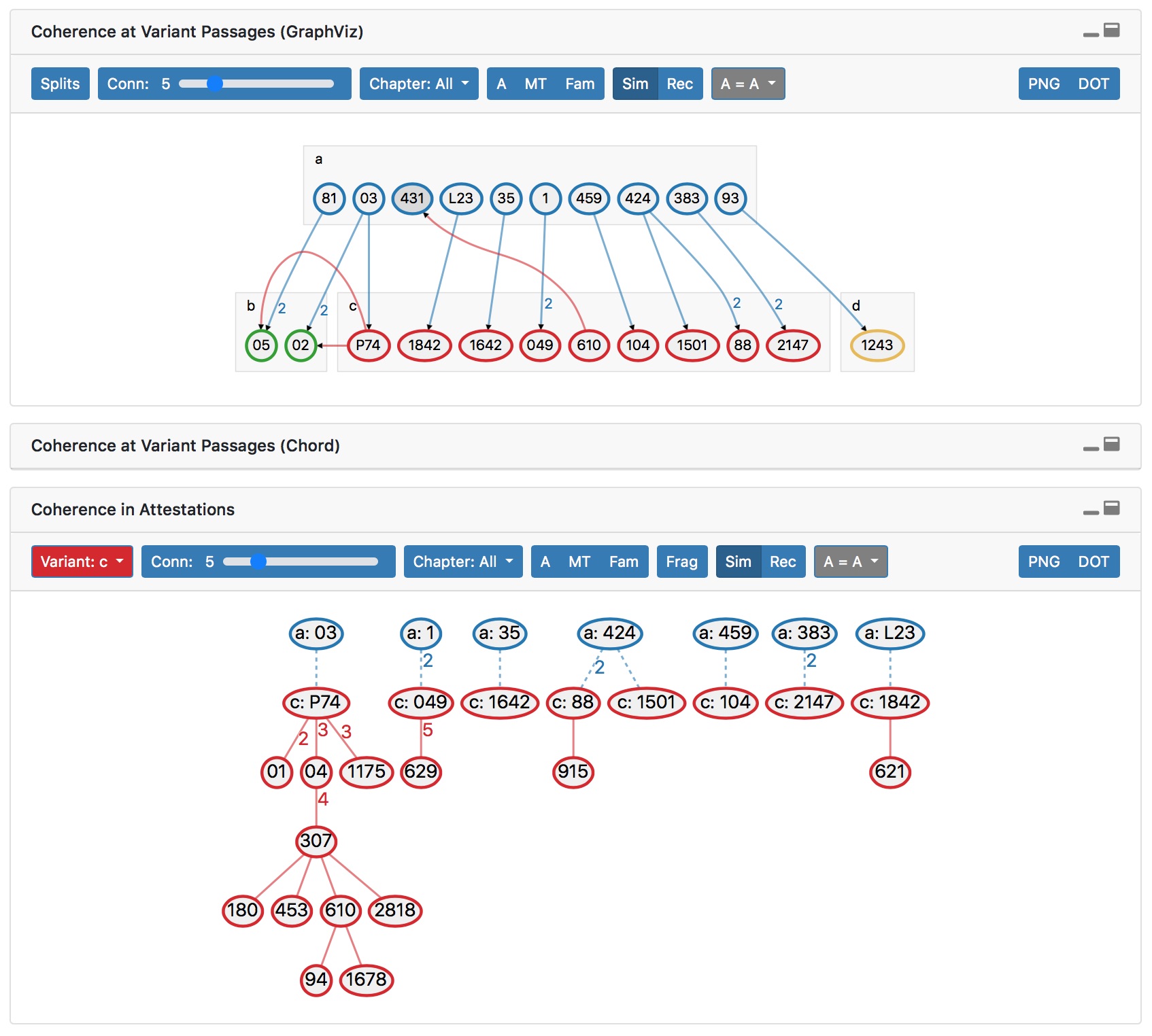The critical apparatus as a gateway to the sources
Shortly after the ECM of Acts appeared in print in 2017, the INTF made the text and apparatus available online in the NT Transcripts section of the NTVMR <http://ntvmr.uni-muenster.de/nt-transcripts>. If you enter a verse from Acts under “Quick Lookup,” you will see the ECM apparatus for this verse in the frame below. Let's take Acts 3:13 as an example.

(Click on this image to access the live page)
If you click on the number of any of the cited Greek manuscripts, the transcription of the relevant verse will appear in the frame to the right. If you want to see a photograph of the page containing this verse, click on the “Manuscript Workspace” link above the verse transcription and the photograph will appear in a separate window together with a full transcription of the page.
Three links above the apparatus offer more materials. “Cit” will take you to the patristic citations for the selected verse, “VL” to line-by-line transcriptions of the Latin manuscripts selected for the Acts Vetus Latina project, and “Conjectures” to the conjectures for the verse as stored in the Amsterdam database.
These features demonstrate the passways we are cultivating to transform the critical apparatus from a meager list of variants and witnesses into a gateway to the sources. Later this year, we will integrate line-by-line transcriptions of the Sahidic manuscripts, and sooner or later the Syriac and the Ethiopic will follow.
In addition, the transcriptions of all Greek manuscripts included in the ECM of Acts, which comprises the main portion of the textual apparatus, are made available to the user.
The textual commentary as a documentation of work on the text
In the left margin of the online apparatus there are two symbols: a blue balloon and a circle with an arrow. Clicking on the balloon will take you to the Textual Commentary section of the NTVMR Forum. Each commentary printed in the Studies volume of ECM Acts was reproduced here. The arrow symbol is linked to the coherence diagrams for the relevant passage in the Genealogical Queries interface.
A primary objective of the ECM is a reconstruction of the initial text of the manuscript tradition, which is not preserved as such in any of the extant copies. We apply the methodology of reasoned eclecticism to reconstruct the initial text. The textual commentary published in the Studies volume of ECM Acts documents this work. It discusses each passage where the reconstruction of the initial text differs from NA28/UBS5, and, secondly, where the decision was left open and the guiding line of the edition is split. Moreover, comments are given if the editors’ assessment needs additional explanation to supplement the guidelines laid down in the commentary introduction.
Reasoned eclecticism is based on pondering internal and external criteria. Ideally, the objective is to identify the variant that best explains the other(s) and, if applicable, that also accounts for relationships between secondary variants. In effect, the discussion will always be about reasons why one form of text is or is not likely to have been changed into another form. That means that the application of internal criteria is successful if transcriptional probability emerges for a textual flow—to use the CBGM term—from one to another variant. Therefore, the discussion of internal criteria is indicated by TP, if that part of the discussion is clearly separated from the other part, GC or genealogical coherence. What TP is for the internal criteria, GC is for the external criteria. Where there are variants, the genealogy of their witnesses will reflect the direction of textual flow, whether we are able to explain the relationships or not. The latter is often due to contamination and/or missing links. (Most of the manuscript tradition from the first millennium is lost.)
The commentary on Acts 3:13/8 is brief. A mouse click on the blue balloon to the left of the apparatus will open the commentary in a separate window. There is just one sentence summarizing a complex picture offered by the Genealogical Queries site for the passage in question:
GC suggests multiple emergence of c from a, while the attestation of a is perfectly coherent and includes a sufficiently broad range of A-related witnesses.
A click on the blue arrow icon beside the apparatus takes us to the relevant lists and diagrams in Genealogical Queries.
Apparatus: One entry for each included witness. Exception: if the evidence is ambiguous, the witness is listed with a question mark for the respective alternatives (cf. 2344 b/c).

Local Stemma: a derives immediately from the initial text (*), c and d from a. A share of the a attestation (a2) does not fit this picture. For this share and for b, the source appears questionable.
Coherence at Variant Passages shows interrelations between witnesses in different attestations. To understand what it displays we have to turn to the next frame.

Coherence in Attestations shows the textual flow diagram for a selected variant. By default this is a. If you go to c, you see a diagram showing poor genealogical coherence. Many witnesses not connected to each other have their closest relatives in the a attestation. Note how all the nodes in the c attestation with close relatives in a are connected to these relatives in Coherence at Variant Passages by arrows pointing from a to c.
The point I want to make here is that the commentary notes on GC require the reader to consult the Genealogical Queries site to get the full picture. It is now easier to do this because Genealogical Queries is an integrated part of the online ECM.
The commentary notes focus on the essential and are often very brief, in many cases reduced to the token “R1” or “R2.” This is possible because the guidelines and rules for assessing variants and their attestations are explained in the Online Commentary Introduction (and related publications cited there). The introduction is accessible via a link that appears above each online commentary.
The textual commentary as a platform for scholarly discourse on the text
Any expert user of the NTVMR may reply briefly (there are “Like” and “Dislike” icons) or at length to an existing commentary. If someone publishes a reply, subscribers of the commentary section of the NTVMR forum will be notified.
Any registered expert user of the NTVMR may additionally register as a commentator, obtaining the right to open a new commentary thread on any passage of the online apparatus where there is no comment so far. To register as a commentator, send an email to <onlinecommentary@uni-muenster.de>
 Personal Blogs
Personal Blogs  RSS (Öffnet neues Fenster)
RSS (Öffnet neues Fenster)  Letzte Blogger
Letzte Blogger 








